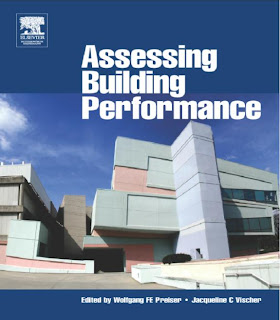 Assessing Building Performance
Assessing Building PerformanceEdited by
Wolfgang F E Preiser
University of Cincinnati, Ohio, USA
Jacqueline C Vischer
University of Montreal, Canada
0750661747 :
Paperback : 256 pages :
100 illustrations :
Autumn 2004, Published by ELSEVIER
Assessing Building Performance addresses building officials/administrators, facility managers, programmers, design professionals, and property owners/managers. Secondary readership is as a text for college courses in facilities management, environmental psychology, architectural programming, post-occupancy evaluation, and design methods.
TABLE OF CONTENTS:
Foreword by Frank Duffy, DEGW, London, UK; Part I: Introduction and Overview - 1) The Evolution of Building Performance Evaluation (Editors); 2) A Conceptual Framework for Building Performance Evaluation (Preiser, and Ulrich Schramm, Fachhochschule Bielefeld, Germany); Part II: Performance Assessments in the 6-Phase Building Delivery and Life Cycle - 3) Phase I: Strategic Planning - Effectiveness Review (Schramm); 4) Phase II: Programming -- Program Review (Alexi Marmot, Joanna Eley and Stephen Bradley, AMA Associates, London, UK); 5) Phase III: Design -- Design Review (Vischer); 6) Phase IV: Construction – Commissioning (Michael J. Holtz, AEC Inc, Boulder, CO, USA); 7) Phase V Occupancy -- Post-Occupancy Evaluation (Bill Bordass, William Bordass Associates, and Adrian Leaman, Building Use Studies, London, UK); 8) Phase VI: Adaptive Re-Use/Recycling - Market/Needs Assessment (Danny S.S. Then, The Hong Kong Polytechnic University, China); Part III: Case Studies - 9) Benchmarking the 'Sustainability' of a Building Project (Sue Roaf, Oxford Brookes University, UK); 10) ASTM Methodology and Case Study (Francoise Szigeti and Gerald Davis, International Centre for Facilities, Ottawa, Canada); 11) Assessing the Performance 'Offices of the Future' (Rotraut Walden, Universität Koblenz, Germany); 12) High-Tech Office Building Evaluation in Brazil (Sheila Ornstein, Claudia Andrade and Brenda Leite, University of Sao Paulo, Brazil); 13) Organizational Lessons From a Government Building Evaluation in Israel (Ahuva Windsor, Colman College of Management, Rishon Lezion, Israel); 14) Building Performance Evaluation in Japan (Akikazu Kato and Pieter Le Roux, Toyohashi University of Technology, and Kazuhisa Tsunekawa, Nagoya University, Japan); 15) Technological and Management Innovation in Offices in The Netherlands (Shauna Mallory-Hill, University of Manitoba, Canada, Theo J.M. van der Voordt, Technical University Delft, Netherlands, Anne van Dortmont, van Wagenberg Associates, Eindhoven, Netherlands); 16) Evaluating Universal Design Performance (Preiser); 17) Facility Performance Evaluation in the Public and Private Sectors (Craig Zimring et al, Georgia Institute of Technology, USA); 18) The Human Elements in Building Performance Evaluation (Alex K. Lam, The OCB Network, Missisauga, Canada); Part IV - 19) Epilogue: Looking to the Future (Vischer); APPENDICES - Kit of Tools: Evaluation Instruments You can Use; Glossary of Terms; Author and Subject Index
For more information about Prof. Wolfgang Preiser, click here>> http://www.daap.uc.edu/people/profiles/preisewg or here>> http://www.daap.uc.edu/stories/Architecture_Professor_Builds_a_World-Renowned_Reputation_as_quot_Building_Pathologist_quot
For More information about Prof. Jacqueline Vischer, click here>> http://www.gret.umontreal.ca/an/team.htm#Vischer
To Download Leaflet of Assessing Building Performance, click here>> http://www.iaps-association.org/Documents/OtherDocs/AssBuildPerf_Preiser.doc
To Order from the Publisher, click here>> http://www.elsevier.com/wps/find/bookdescription.cws_home/703640/description#description